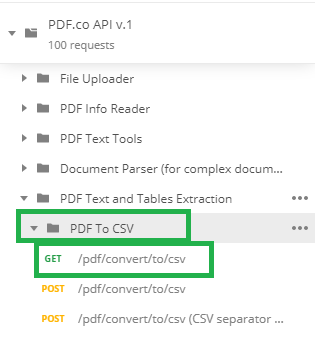

- #Postman download csv file how to
- #Postman download csv file install
- #Postman download csv file verification
- #Postman download csv file password
The URL (paste in your IP address and your value for “_ref” that you got from the previous query) “ …”.
#Postman download csv file password
#Postman download csv file verification
Make sure SSL certificate verification is turned off in Postman settings or preferences.
#Postman download csv file how to
Here are a few screenshots on how to configure “Postman” to get the EA “_ref” We are going to use “Postman” to make an API call my Infoblox appliance to call an Extensible Attributes called “Names” which is a list.
#Postman download csv file install
Go to download it for your OS and follow there install guide Log into your NIOS box and create an EA with the name of “Names” type of List and add a value “Testvalue” The list of values was in the form of a CSV file. Since this API echoes back whatever is sent to it, we’re asserting that the returned value from Echo is the same as the one dictated by our file.ĭata variables can be used in all places that environment variables can be used, in the exact same way, except in pre-request & test scripts.I have a customer that did not have access to run a Python Script so I came up with the idea of using Postman to do it. data is an object with all variables you defined in your file as it’s keys. With each iteration, it’s value is updated with new data from our file.

The variable data is a predefined variable that gets the values from the data file.

Let’s also take a look at our test scripts once again. This way, we’ve thrown different kinds of data to our API and have ensured that it works correctly for each case. In fact, for different iterations, this value is different. If you open up the request debug tooltip, and expand Request Body, you’ll see that the variable was replaced by the value, as dictated by the data file. Click Select File in the Runner, and select one of these files. You can also preview what values each variable has in each iteration by clicking on Preview next to the file name. Now that you understand how to construct data files, let’s supply this data file to a Collection Run.

For the second iteration, path is still post, but value is 2.ĭo note that you can only use one data file for one run. For iteration 1, path has value post, and value is 1. In typical CSV fashion, the first row represents all variable names, and subsequent rows represent values for these variables for each iteration. The Postman Sandbox initializes the data variable from the JSON/CSV file that we will select in the collection run. On opening the test script, you’ll see we’re using some variables in the test script - data specifically. We will supply the value to these variables using a JSON / CSV file. These are used just like environment variables. If you open up this request, you’ll see two variables used in the request, path (in the URL) & value (in the request body). Here, we have a simple collection with a single POST request. Download the collection and data files used in this example: We can think of data files are parameters for each iteration of a collection run. Data files are extremely powerful ways to test your APIs with varying data to check if they behave properly under unexpected circumstances.


 0 kommentar(er)
0 kommentar(er)
